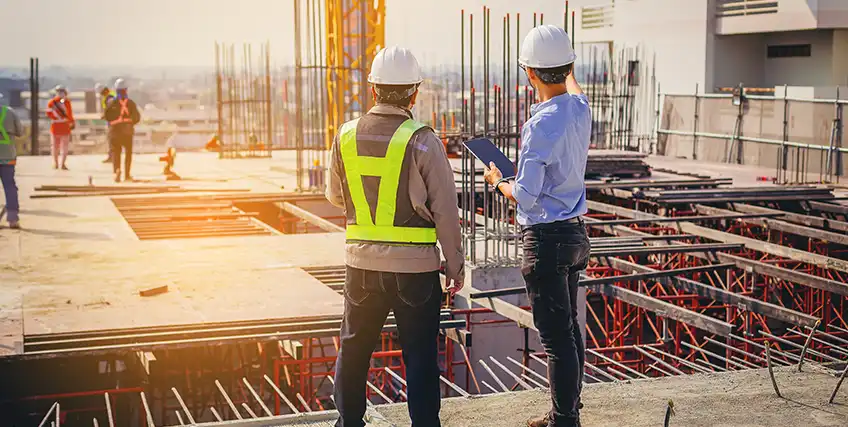Mastering Commercial Construction Financing: A Complete Guide for Homebuilders
March 03, 2025 | Last Updated on: March 05, 2025

In the dynamic world of homebuilding, securing commercial construction financing is a pivotal step toward transforming blueprints into real-world homes for families. Understanding the nuances of construction financing is not just beneficial but essential for homebuilders aiming to undertake projects such as single-family homes, multi-family apartment buildings, and other residential developments. This article seeks to demystify the intricacies of commercial construction loan financing, explore the types of commercial construction loans available, and prepare you for the application process to expedite your business loan's approval.
Understanding Construction Loans
Construction loans are specifically designed to finance residential construction projects, whether they involve single-family homes, multi-family apartments, or other residential real estate property. Unlike traditional long-term commercial mortgages, construction loans are short-term in nature and typically last one year or less. These loans cover the construction costs of your project, including purchasing land, building materials, labor, and other associated expenses.
Once the project is complete, the loan is either paid off through a traditional mortgage (if using a construction-to-permanent loan) or refinanced into a permanent commercial mortgage (in the case of stand-alone construction loans). The goal of commercial construction financing is to ensure business owners can complete their projects on time and then transition smoothly into long-term funding.
Types of Commercial Construction Loans
Construction-to-Permanent Loans
This financing option simplifies the borrowing process by combining construction and long-term financing into one loan. During construction, the loan operates as a short-term construction loan with interest-only payments.
Once construction is complete, the loan automatically transitions into a permanent mortgage, often with a fixed interest rate for the long term. This type of commercial construction financing eliminates the need for a second closing, making it a popular choice for homebuilders who want simplicity.
The impact on commercial real estate loans using this option is to streamline the process, reduce costs, and ensure that financing is secured once construction is complete.
Stand-Alone Construction Loans
In contrast to the construction-to-permanent loan, stand-alone loans only cover the construction phase. Once the project is completed, homebuilders must secure a separate, long-term commercial mortgage to pay off the loan. Homebuilders may choose traditional bank financing or turn to SBA loans, like the SBA 7(a) and 504 loans, for more favorable underwriting criteria and competitive rates.
While this short-term loan option can provide lower interest rates for the permanent mortgage, it involves two different loan processes: one for construction and another for refinancing the loan into a mortgage. This can be a bit more complex and may involve higher overall costs due to additional fees and administrative tasks.
Additionally, there is no guarantee that your project will be able to secure stand-alone financing once the project is complete. Changing interest rates, lender appetite, credit scores, and company finances all contribute to the risk of getting permanent financing.
Renovation Construction Loans
Homebuilders looking to purchase and remodel existing properties often turn to renovation construction loans. These loans are tailored to cover the costs of extensive renovations or additions.
Lenders typically require homebuilders to submit detailed renovation plans and a cost estimate for the work. The loan amount is often based on the property's projected appraised value (ARV) after renovations, which can offer flexibility for those seeking to upgrade older homes into modern living spaces.
Owner-Builder Construction Loans
An owner-builder loan is designed for individuals who want to act as their own general contractor during construction. This type of financing can save money by removing the costs associated with hiring a general contractor, but it also comes with more risk and demands more expertise.
Lenders typically require a strong track record of successful construction projects and solid financial standing to approve owner-builder loans. If you don't have the necessary experience, the lender may require a larger down payment, higher interest rates, and other loan covenants to reduce risk.
Qualifying for a Construction Loan
Key Criteria for Loan Approval
- Creditworthiness: When applying for commercial construction financing, your credit score plays a significant role in determining loan approval. A higher personal and business credit score typically results in better loan terms, including lower interest rates and more favorable repayment terms. Builders with lower credit scores may face higher interest rates or be required to provide additional documentation to secure the loan.
- Income Verification: A steady income is essential when securing any loan, including commercial construction financing or a line of credit. Lenders require proof of consistent earnings, typically tax returns, bank statements, and audited income statements & balance sheets, to ensure the borrower can meet financial obligations during construction. Additionally, a favorable debt-to-income ratio, which indicates the borrower’s ability to handle additional debt, can also improve the chances of approval.
- Down Payment Requirements: Most construction loans require a down payment that is higher than that of traditional mortgages. While standard mortgages may only require 20%, construction loans often necessitate down payments of 20% to 25%. Homebuilders should be prepared to provide the necessary funds from their savings or other financing means. A substantial down payment also demonstrates a borrower’s commitment and financial stability, potentially increasing the likelihood of loan approval and receiving favorable loan terms.
- Project Plans and Specifications: For any construction loan, lenders will require detailed plans and specifications for the project. This typically includes blueprints, cost estimates, and timelines, often provided by licensed contractors and architects. Clear and comprehensive plans demonstrate to lenders that the project is well thought out, reducing the perceived risk of the loan. The lender may also use these plans to determine milestones the borrower needs to meet to unlock additional funding rather than funding the entire loan upfront.
Additional Considerations for Approval
Construction Timeline
A well-planned and realistic construction timeline is vital for securing commercial construction financing. Lenders prefer projects that have set timelines, minimizing the risk of delays. Unforeseen delays or extended construction periods can lead to increased costs, affecting the lender's willingness to finance the project.
Failure to meet certain deadlines may forfeit access to funds, trigger interest rate increases, or cause the lender to call the loan.
Builder's Experience and Reputation
Lenders often evaluate the builder's track record to assess the risk of loan approval. Builders with a history of successfully completing projects on time and within budget are viewed more favorably.
Homebuilders can improve their chances by showcasing past projects, including references from previous clients, and maintaining a strong industry reputation for reliability and quality work.
What Homebuilders Need to Know About Construction Loans
Interest Rates and Payment Structure
Interest rates on commercial construction financing are often variable and can fluctuate depending on market conditions. It's important for homebuilders to understand how these rates will be applied throughout the loan’s duration. Failure to account for interest rate fluctuations can turn a profitable project into a money-loser.
During the construction phase, many loans require interest-only payments, which can ease financial strain in the short term. However, once the project transitions to permanent financing, the variable commercial construction loan rate structure may change to a fixed-rate mortgage.
Loan Disbursement Process
Construction loans are typically disbursed in phases, known as “draws” or a “draw schedule,” based on the completion of various milestones in the project. For example, funds may be released after the foundation is laid, the framing is completed, or the roof is installed.
Homebuilders should be prepared for regular inspections from the lender to verify that each phase has been completed before funds are disbursed. Managing cash flow effectively during this process is crucial to maintaining momentum and completing the project on schedule.
Risk Management
Homebuilding projects are inherently risky, and unexpected issues can arise, from cost overruns to delays caused by weather or supply shortages. To mitigate these risks, homebuilders should establish contingency funds within their project budget.
Lenders may require homebuilders to set aside a certain percentage of the total loan amount for unforeseen costs. This precaution helps ensure the project continues smoothly, even in the face of setbacks.
Legal and Regulatory Compliance
Navigating the legal landscape is another critical aspect of construction financing. Homebuilders must adhere to local zoning laws, building codes, and permit requirements.
Non-compliance with legal and regulatory requirements can lead to costly fines or project delays, which in turn could jeopardize loan approval or repayment terms.
Tips for Securing the Best Construction Loan
Shopping Around for Lenders
Different lenders offer varying terms and rates for commercial construction financing. It’s essential to shop around and compare offers from multiple institutions. Credit unions, banks, online lenders, and specialized construction lenders may provide unique loan products designed to meet the needs of homebuilders.
Homebuilders can secure the best possible rates and terms by comparing multiple loan offers. Some lenders may offer better loan terms or higher approval rates if you have an existing relationship or are willing to move your banking relationship.
Negotiating Terms and Conditions
Negotiation plays a significant role in securing favorable loan terms. Homebuilders should be prepared to discuss interest rates, repayment schedules, and other key terms with lenders.
Highlighting the strengths of the project, such as strong demand in the area or the reputation of the builder, can help in securing better loan terms and interest rates.
Building Strong Relationships with Lenders
Establishing a strong rapport with lenders can go a long way in securing favorable loan terms. Open communication, trust, and transparency throughout the application process can help homebuilders gain confidence from lenders. By demonstrating a clear vision for the project and addressing potential concerns, builders can foster a positive relationship that may benefit them in the future.
The Bottom Line About Commercial Construction Financing
Commercial construction financing is vital for homebuilders embarking on residential projects, from single-family homes to multifamily apartments. Understanding the various loan options, qualification criteria, and effective strategies for securing favorable terms is crucial for success. By carefully managing the loan application process, improving creditworthiness, and negotiating favorable terms, homebuilders can unlock the capital needed to bring their construction projects to life.
The right commercial construction financing can empower homebuilders to create high-quality residential properties while confidently navigating financial challenges. By staying informed, prepared, and proactive, builders can secure the commercial construction financing necessary to fuel their construction endeavors, ensuring the success of their projects and their place in the competitive real estate market.
Frequently Asked Questions (FAQs)
What is the difference between a construction loan and a mortgage?
A construction loan is short-term, high-interest commercial construction financing designed to cover the costs of building a new home or undertaking major renovations. It provides the necessary funds for materials, labor, and other expenses during construction. Conversely, a mortgage is a long-term loan used to finance the purchase of a completed property.
Can I get a construction loan without a down payment?
While it is uncommon, it is possible to secure commercial construction financing without a down payment. Specialized lenders may offer zero-down-payment loans for highly qualified borrowers or for specific types of construction projects.
What is the typical repayment period for construction loans?
The repayment period for commercial construction financing is usually short-term, depending on the project's scope. During the construction phase, borrowers often make interest-only payments. Once the project is completed, the loan either converts to a permanent mortgage (in the case of a construction-to-permanent loan) or must be refinanced into a separate 15 to 30-year mortgage to pay off the loan balance.
How can I improve my chances of loan approval?
Improving your chances of business loan approval for commercial construction financing involves a combination of financial preparedness and project planning. Maintain a strong credit score, ideally above 700, and be ready to provide proof of a steady income. Prepare a detailed and well-organized construction plan with realistic timelines and cost estimates and have a substantial down payment (typically 20-25%) to reduce the amount you need to borrow.
What happens if my project is delayed or goes over budget?
Delays and cost overruns are common in construction projects, but they can affect the progress of a construction loan. Lenders typically require homebuilders to include a contingency reserve to cover unexpected costs. If a project is delayed, the borrower may need to request an extension on the loan, which can come with additional fees or adjustments to the loan terms. If the project exceeds the initial budget, additional funding may be required, and the borrower could need to secure supplemental financing.




